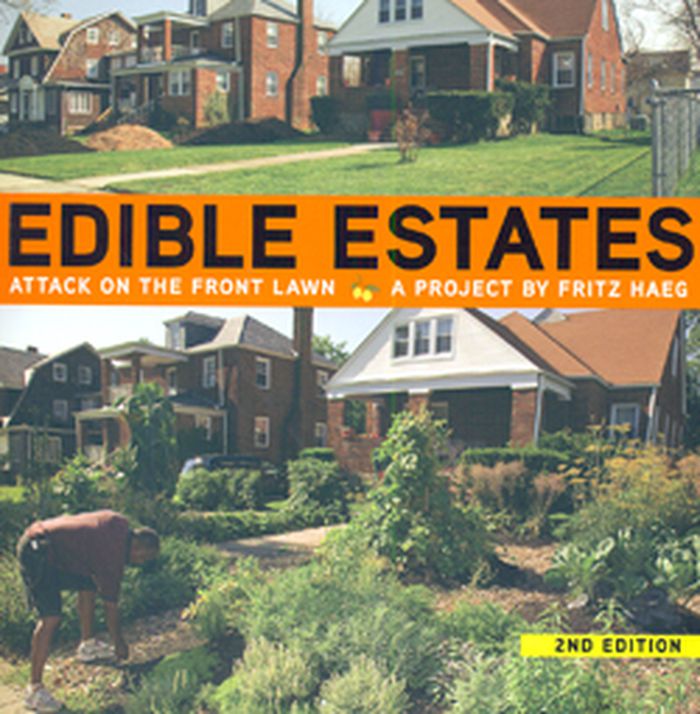$29.00
(available to order)
Summary:
Preface by Fritz Haeg. Texts by Fritz Haeg, Diana Balmori, Rosalind Creasy, Michael Pollan, Lesley Stern, Michelle Christman, Stan Cox, Michael Foti. The Edible Estates project proposes the replacement of the domestic front lawn with a highly productive edible landscape. It was initiated by architect and artist Fritz Haeg on Independence Day, 2005, with the planting of(...)
Edible estates: Attack on the front lawn. A project by Fritz Haeg
Actions:
Price:
$29.00
(available to order)
Summary:
Preface by Fritz Haeg. Texts by Fritz Haeg, Diana Balmori, Rosalind Creasy, Michael Pollan, Lesley Stern, Michelle Christman, Stan Cox, Michael Foti. The Edible Estates project proposes the replacement of the domestic front lawn with a highly productive edible landscape. It was initiated by architect and artist Fritz Haeg on Independence Day, 2005, with the planting of the first regional prototype garden in the geographic center of the United States, Salina, Kansas. Since then three more prototype gardens have been created, in Lakewood, California; Maplewood, New Jersey and London, England. Edible Estates regional prototype gardens will ultimately be established in nine cities across the United States. Edible Estates: Attack on the Front Lawn documents the first four gardens with personal accounts written by the owners, garden plans and photographs illustrating the creation of the gardens--from ripping up the grass to harvesting a wide variety of fruits, vegetables and herbs. Essays by Haeg, landscape architect Diana Balmori, garden and food writer Rosalind Creasy, author Michael Pollan and artist and writer Lesley Stern set the Edible Estates project in the context of larger issues concerning the environment, global food production and the imperative to generate a sense of community in our urban and suburban neighborhoods. This smart, affordable and well-designed book also includes reports and photographs from the owners of other edible front yards around the country, as well as helpful resources to guide you in making your own Edible Estate.
Landscape Theory
$27.00
(available to order)
Summary:
Since the first edition of "Edible Estates : Attack on the Front Lawn" was published in 2008, interest in edible gardening has exploded across the United States and abroad. This greatly expanded second edition of the book documents the eight Edible Estates regional prototype gardens that author Fritz Haeg has planted in California, Kansas, Texas, Maryland, New Jersey, New(...)
Edible estates : attack on the front lawn, 2nd edition
Actions:
Price:
$27.00
(available to order)
Summary:
Since the first edition of "Edible Estates : Attack on the Front Lawn" was published in 2008, interest in edible gardening has exploded across the United States and abroad. This greatly expanded second edition of the book documents the eight Edible Estates regional prototype gardens that author Fritz Haeg has planted in California, Kansas, Texas, Maryland, New Jersey, New York and England, and includes personal accounts from the homeowner-gardeners about the pleasures and challenges of publicly growing food where they live. Ten "Reports from Coast to Coast" tell the stories of others who have planted their own edible front yards in towns and cities across the country. In addition to essays by landscape architect and scholar Diana Balmori, edible-landscaping pioneer Rosalind Creasy, bestselling author and sustainable-food advocate Michael Pollan and artist and writer Lesley Stern, this edition features updated text by Haeg (including his observations on the Obama White House vegetable garden); a contribution from Mannahatta author Eric W. Sanderson; and Growing Power founder, MacArthur Fellow and urban farmer Will Allen's never-before-published Declaration of the Good Food Revolution. This is not a comprehensive how-to book, nor a showcase of impossibly perfect gardens. The stories presented here are intended to reveal something about how we are living today and to inspire readers to plant their own versions of an Edible Estate. If we see that our neighbor's typical grassy lawn instead can be a beautiful food garden, perhaps we will begin to look at the city around us with new eyes. Our private land can be a public model for the world in which we would like to live.

